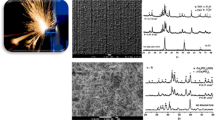Abstract
The sol-gel prepared titania (TiO2) has recently been demonstrated with a promising bioactivity [1]. It forms a chemical bond with the living bone in the body, although the bonding is not very strong. The present study is intended to improve the bone-bonding ability of the titania gel. The goal is achieved by impregnating the titania with hydroxyapatite (Ca10(PO4)6(OH)2). The processing route includes the following steps: (1) the titania sol solution was prepared; (2) the solution was mixed with fine hydroxyapatite (HA) powders; (3) the mixture was used to produce a coating on a commercial pure titanium (c.p. Ti) or Ti6A14V plate by a dip coating technique; (4) the coating was fired at 400–600°C. The resulting coating is a composite consisting of hydroxyapatite embedded in the matrix of the titania gel. Such HA-TiO2 composite coating is capable of inducing the hydroxyapatite precipitation from a simulated body fluid. When implanted in femurs of goat, the composite coating shows a bonding with bone. Its bone-bonding strength is twice as high as that of the pure titania gel coating. The results indicate that impregnating with hydroxyapatite is a promising way to increase the bioactivity of the titania gel.
Similar content being viewed by others
References
P.Li and K.deGroot, Calcium phosphate formation within sol-gel prepared titania in vitro and in vivo. J. Biomed. Mater. Res. 27, 1495–1500 (1993).
K.Hayashi, K.Uenoyama, N.Matsuguchi, S.Nakagawa, and Y.Sugioka, The affinity of bone to hydroxyapatite and alumina in experimentally induced osteoporosis. J. Arthroplasty 4, 257–262 (1989).
H.Ohgushi, M.Okumura, T.Yoshikawa, K.Inoue, N.Senpuku, and S.Tamai, Bone formation process in porous calcium carbonate and hydroxyapatite. J. Biomed. Mater. Res. 26, 885–895 (1992).
M.Jarco, Calcium phosphate ceramics as hard tissue prosthetics. Clin. Orthop. 157, 259–278 (1981).
K.deGroot, Bioceramics consisting of calcium phosphate salts. Biomaterials 1, 47–50 (1981).
K.deGroot, Medical applications of calciumphosphate bioceramics. J. Ceram. Soc. Japan 99, 943–953 (1991).
R.G.T.Geesink, K.deGroot, and C.P.A.T.Klein, Chemical implant fixation using hydroxyl-apatite coatings. Clin. Orthop. 225, 147–170 (1987).
S.D.Cook, K.A.Thomas, J.F.Kay, and M.Jacho, Hydroxyapatite-coated titanium for orthopedic implant applications. Clin, Orthop. 232, 225–243 (1988).
J.G.C.Wolke, J.M.A.deBlieck-Hogervorst, W.J.A.Dhert, C.P.A.T.Klein, and K.deGroot, Studies on the thermal spraying of apatite bioceramics. J. Thermal Spray Technology 1, 75–82 (1992).
J.F.Kay, Plasma sprayed hydroxyapatite coatings for enhanced biocompatibility. Mat. Tech. 8, 26–29 (1993).
L.L.Hench and J.Wilson, Surface-active biomaterial. Science 226, 630–636 (1984).
L.L.Hench, Bioceramics: From concept to clinic. J. Am. Ceram. Soc. 74, 1487–1510 (1991).
T.Kokubo, Recent progress in glass-based materials for biomedical applications. J. Ceram. Soc. Japan 99, 965–973 (1991).
P.Li and K.deGroot, Better bioactive ceramics through sol-gel process. J. Sol-Gel Science and Technology 2, 797–801 (1994).
P.Li, C.Ohtsuki, T.Kokubo, K.Nakanishi, N.Soga, T.Kanamura, and T.Yamamuro, Apatiteformation induced by silica gel in a simulated body fluid. J. Am. Ceram. Soc. 75, 2094–97 (1992).
J.K.West and L.L.Hench, Reaction Kinetics of Bioactive Ceramics Part V: Molecular Orbital Modeling of Bioactive Glass Surface Reaction, in Bioceramics 5, edited by T.Yamamuro, T.Kokubo, and T.Nakamura (Kobunshi Kankokai, Inc. Kyoto, Japan 1992), pp. 75–86.
P.Li, K.deGroot, and T.Kokubo, Bonelike hydroxyapatite induction by sol-gel derived titania coating on a titanium substrate. J. Am. Ceram. Soc. 77, 1307–1315 (1994).
P.Li, C.Ohtsuki, T.Kokubo, K.Nakanish, N.Soga, and K.deGroot, A role of hydrated silica, titania and alumina in forming biologically active bone-like apatite on implant. J. Biomed. Mater. Res. 28, 7–15 (1994).
T.Kokubo, H.Kushitani, S.Sakka, T.Kitsugi, and T.Yamauro, Solution able to reproduce in vivo surface-structure changes in bioactive glass-ceramic A.-W. J. Biomed. Mater. Res. 24, 721–734 (1990).
J.D. de Bruijn, Y.P. Bovell, J. vd Meer, P. Nijweide, and P. Li, Osteoclast responses to calcium phosphates and dentin pre-treated with simulated body fluid to produce a surface carbonate-apatite layer. Transactions of 21 st Society for Biomaterials Meeting (San Francisco, California, USA, 1995), p. 152.
Author information
Authors and Affiliations
Rights and permissions
About this article
Cite this article
Li, P., de Groot, K. & Kokubo, T. Bioactive Ca10(PO4)6(OH)2−TiO2 composite coating prepared by sol-gel process. J Sol-Gel Sci Technol 7, 27–34 (1996). https://doi.org/10.1007/BF00401880
Received:
Accepted:
Issue Date:
DOI: https://doi.org/10.1007/BF00401880




